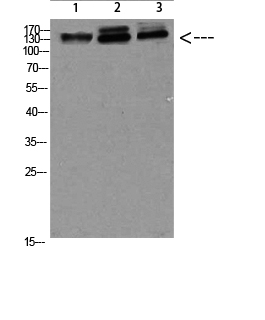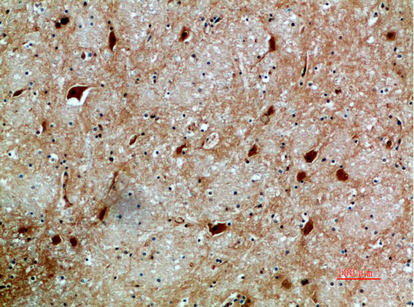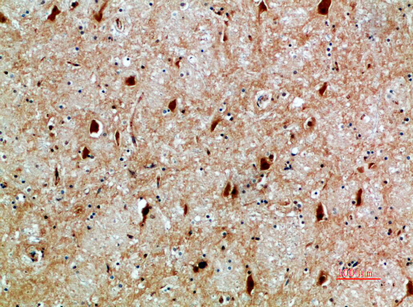


| WB | 咨询技术 | Human,Mouse,Rat |
| IF | 咨询技术 | Human,Mouse,Rat |
| IHC | 1/50-1/100 | Human,Mouse,Rat |
| ICC | 技术咨询 | Human,Mouse,Rat |
| FCM | 咨询技术 | Human,Mouse,Rat |
| Elisa | 1/10000 | Human,Mouse,Rat |
| Aliases | KIAA0827 TONEBP |
| Entrez GeneID | 10725 |
| WB Predicted band size | Calculated MW: 166 kDa; Observed MW: 150-160 kDa |
| Host/Isotype | Rabbit IgG |
| Antibody Type | Primary antibody |
| Storage | Store at 4°C short term. Aliquot and store at -20°C long term. Avoid freeze/thaw cycles. |
| Species Reactivity | Human,Mouse,Rat |
| Immunogen | Synthetic peptide from human protein at AA range: 212-284 |
| Formulation | Purified antibody in PBS with 0.05% sodium azide,0.5%BSA and 50% glycerol. |
+ +
以下是关于NFAT5抗体的参考文献示例(仅供参考,具体文献需根据实际检索结果调整):
1. **"NFAT5 regulates macrophage immune responses through osmotic stress signaling"**
*作者:Lee JH, et al.*
摘要:研究NFAT5在巨噬细胞炎症反应中的作用,利用特异性NFAT5抗体通过Western blot和免疫荧光证实其在细胞核内的渗透压依赖性激活,揭示其通过调控炎症因子表达参与先天免疫应答。
2. **"NFAT5 promotes renal cell carcinoma progression by enhancing HIF-1α signaling"**
*作者:Zhang Y, et al.*
摘要:探讨NFAT5在肾癌中的功能,通过免疫组化(使用NFAT5抗体)发现其高表达与患者预后不良相关,并证明NFAT5通过稳定HIF-1α促进肿瘤血管生成和侵袭。
3. **"Characterization of a novel monoclonal antibody for NFAT5 and its application in diabetic nephropathy models"**
*作者:Wang Q, et al.*
摘要:开发并验证一种高特异性抗NFAT5单克隆抗体,应用于糖尿病肾病小鼠模型的肾组织染色,证实NFAT5在肾脏高渗应激下的表达上调及其与纤维化标志物的共定位。
4. **"NFAT5 deficiency in T cells attenuates autoimmune encephalomyelitis by regulating Th17 differentiation"**
*作者:Molina A, et al.*
摘要:通过条件性敲除T细胞中的NFAT5.结合抗体介导的蛋白检测(流式细胞术、ChIP),揭示NFAT5通过调控IL-17A转录影响多发性硬化症模型中的Th17细胞分化。
---
建议通过PubMed或Google Scholar以“NFAT5 antibody” + “应用领域(如cancer, immune等)”检索最新文献,并筛选实验方法部分明确提及抗体使用的研究。
NFAT5 (Nuclear Factor of Activated T-cells 5), also known as TonEBP (Tonicity-Responsive Enhancer-Binding Protein), is a transcription factor critical for cellular adaptation to hyperosmotic stress. Unlike other NFAT family members, NFAT5 is activated by elevated extracellular tonicity and regulates the expression of osmoprotective genes, such as those encoding aldose reductase and sodium/myo-inositol transporters, to restore cellular osmotic balance. Beyond osmoregulation, NFAT5 participates in immune responses, inflammation, and cancer progression by modulating genes involved in cell survival, proliferation, and migration.
NFAT5 antibodies are essential tools for studying its expression, localization, and function in various physiological and pathological contexts. These antibodies enable detection of NFAT5 in techniques like Western blotting, immunohistochemistry (IHC), immunofluorescence (IF), and flow cytometry. Researchers use them to investigate NFAT5's role in diseases such as renal disorders, autoimmune conditions, and tumors, where dysregulated NFAT5 activity correlates with disease severity. Commercial NFAT5 antibodies are typically raised against specific epitopes, often targeting conserved regions like the N-terminal or DNA-binding domains. Validation includes testing in knockout models or siRNA-treated cells to ensure specificity. Proper antibody selection depends on the application, species reactivity (human, mouse, rat), and post-translational modifications of interest. Understanding NFAT5's dual role in osmotic stress and disease pathways underscores the importance of reliable antibodies in advancing therapeutic research.
×